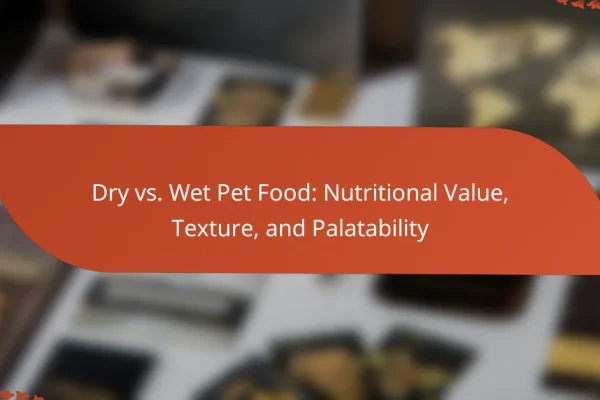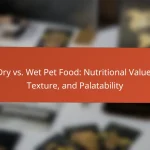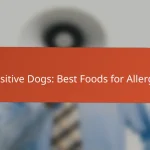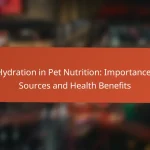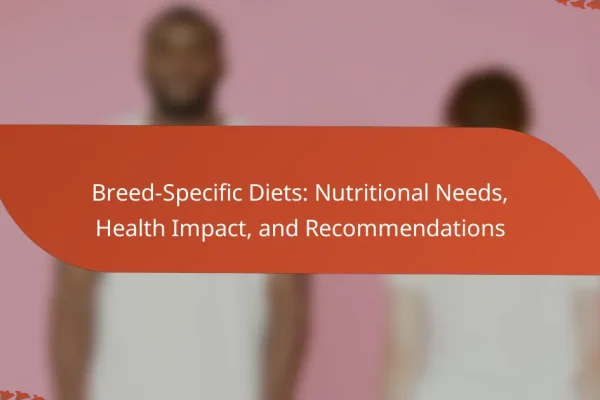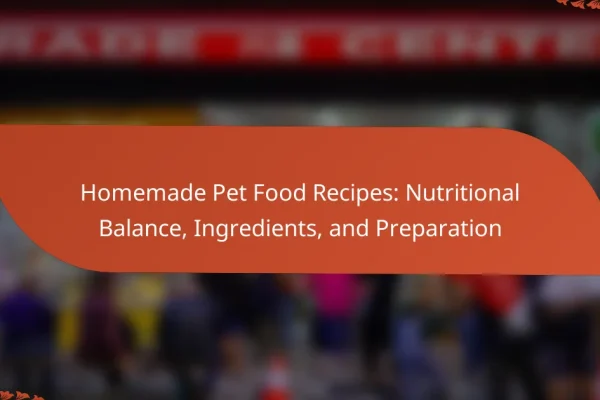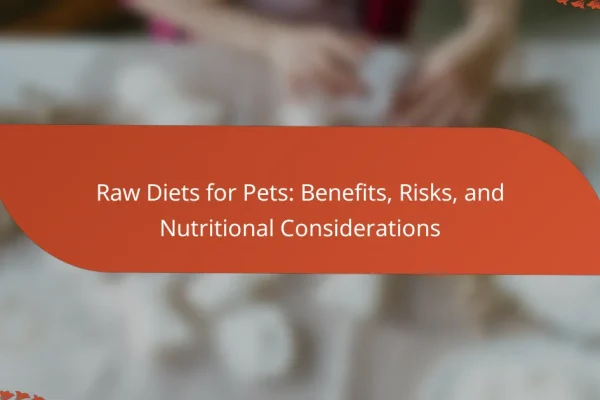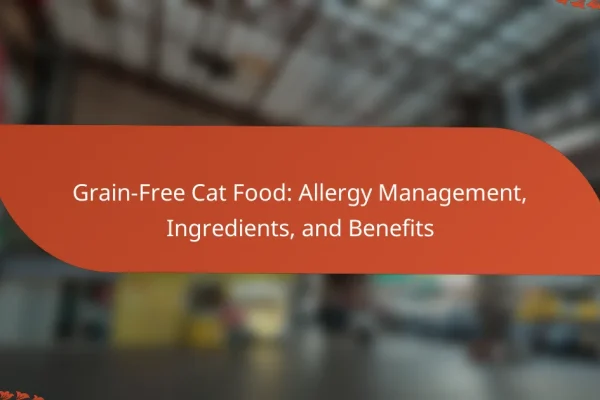What are the best types of pet food for dogs?
The best types of pet food for dogs include dry kibble, canned wet food, raw food diets, grain-free options, and prescription diets. Each type has its own benefits and considerations, making it essential to choose based on your dog’s specific needs and health requirements.
Dry kibble
Dry kibble is a popular choice due to its convenience and long shelf life. It typically contains a balanced mix of proteins, carbohydrates, and fats, which can support a dog’s overall health. When selecting dry kibble, look for products with high-quality ingredients and appropriate protein levels for your dog’s age and size.
One advantage of dry kibble is its ability to help maintain dental health by reducing plaque buildup. However, ensure your dog has access to fresh water, as dry food can be dehydrating.
Canned wet food
Canned wet food is often more palatable for dogs and can be a good option for picky eaters. It usually contains higher moisture content, which can help with hydration, especially for dogs that do not drink enough water. When choosing canned food, check for meat as the primary ingredient and avoid those with excessive fillers.
Wet food can be more expensive than dry kibble, but it can be mixed with kibble to enhance flavor and texture. Be mindful of the calorie content to prevent overfeeding.
Raw food diet
A raw food diet consists of uncooked meat, bones, fruits, and vegetables. Proponents argue that it mimics a dog’s natural diet and can lead to improved coat condition and energy levels. If considering this diet, it’s crucial to ensure a balanced nutritional profile and consult with a veterinarian to avoid potential health risks.
Raw diets require careful handling to prevent bacterial contamination. If you choose this route, consider pre-packaged raw food options that meet safety standards and nutritional guidelines.
Grain-free options
Grain-free dog food eliminates grains like wheat, corn, and soy, which some dogs may be allergic to or have difficulty digesting. These options often use alternative carbohydrates such as sweet potatoes or peas. Grain-free diets can be beneficial for dogs with specific dietary sensitivities.
However, recent studies have raised concerns about potential links between grain-free diets and certain heart conditions in dogs. Consult your veterinarian before making a switch to ensure it is appropriate for your pet.
Prescription diets
Prescription diets are specially formulated to address specific health issues, such as allergies, obesity, or kidney disease. These diets are available through veterinarians and are tailored to meet the unique needs of dogs with medical conditions. Always follow your vet’s recommendations when considering a prescription diet.
While prescription diets can be effective, they may be more expensive than regular pet food. Monitor your dog’s response to the diet and maintain regular veterinary check-ups to assess their health and nutritional needs.
What are the best types of pet food for cats?
The best types of pet food for cats include dry kibble, canned wet food, raw food diets, limited ingredient diets, and high-protein formulas. Each type has its own benefits and considerations, making it essential to choose based on your cat’s specific needs and preferences.
Dry kibble
Dry kibble is a popular choice for cat owners due to its convenience and long shelf life. It typically contains a balanced mix of proteins, fats, and carbohydrates, which can help maintain dental health by reducing plaque buildup.
When selecting dry kibble, look for options with high-quality protein sources listed as the first ingredient. Avoid those with excessive fillers or artificial additives, as these can detract from nutritional value.
Canned wet food
Canned wet food is often more palatable for cats and provides additional moisture, which is beneficial for hydration. This type of food usually contains higher protein levels and fewer carbohydrates compared to dry kibble.
Consider incorporating wet food into your cat’s diet, especially if they are prone to urinary tract issues or are not drinking enough water. Look for options that list meat or fish as the primary ingredient and avoid those with excessive grains.
Raw food diet
A raw food diet consists of uncooked meat, organs, and bones, aiming to mimic a cat’s natural diet. Proponents argue that this diet can lead to healthier skin, a shinier coat, and improved digestion.
However, feeding raw requires careful handling to avoid bacterial contamination and ensure balanced nutrition. Consult with a veterinarian before transitioning to a raw diet, and consider using commercially prepared raw options that meet safety standards.
Limited ingredient diets
Limited ingredient diets are designed for cats with food sensitivities or allergies. These diets typically contain fewer ingredients, focusing on a single protein source and a limited number of carbohydrates.
When choosing a limited ingredient diet, monitor your cat for any adverse reactions and consult with a veterinarian to identify the best options. These diets can help pinpoint allergens and provide relief from gastrointestinal issues.
High-protein formulas
High-protein formulas are tailored for active or growing cats, providing essential amino acids for muscle development and overall health. These diets often feature meat as the primary ingredient and are lower in carbohydrates.
When selecting high-protein food, ensure it meets the nutritional adequacy standards set by organizations like AAFCO. This ensures that the food provides a balanced diet suitable for your cat’s life stage and activity level.
How to choose the right pet food?
Choosing the right pet food involves understanding your pet’s specific needs based on age, dietary requirements, ingredient quality, and professional advice. Prioritizing these factors ensures your pet receives balanced nutrition tailored to their health and lifestyle.
Consider pet’s age
Your pet’s age significantly influences their nutritional needs. Puppies and kittens require food rich in protein and calories to support growth, while adult pets need a balanced diet to maintain health, and senior pets often benefit from lower calories and joint-supporting nutrients.
Look for age-specific formulas on pet food labels. For example, “puppy” or “kitten” foods are designed for younger animals, while “senior” formulas cater to older pets, ensuring they get the right nutrients for their life stage.
Evaluate dietary needs
Assessing your pet’s dietary needs is crucial for their overall health. Consider any allergies, sensitivities, or specific health conditions that may require special diets, such as grain-free or low-fat options.
For instance, dogs with allergies may need limited-ingredient diets, while cats with urinary issues might benefit from foods formulated to promote urinary health. Always read labels carefully to ensure the food meets these dietary requirements.
Check ingredient quality
Ingredient quality plays a vital role in pet food selection. Look for high-quality protein sources, such as chicken or fish, listed as the first ingredient, and avoid foods with excessive fillers like corn or soy.
Additionally, check for the presence of whole foods and avoid artificial preservatives, colors, or flavors. Foods that meet AAFCO standards are generally a good choice, as they ensure nutritional adequacy.
Consult a veterinarian
Consulting a veterinarian is essential when selecting the right pet food. They can provide personalized recommendations based on your pet’s health, age, and lifestyle, ensuring you make an informed choice.
Regular check-ups can also help monitor your pet’s weight and health, allowing for adjustments in diet as needed. Don’t hesitate to ask your vet about specific brands or formulations that may suit your pet best.
What are the benefits of grain-free pet food?
Grain-free pet food offers several advantages, particularly for pets with specific dietary needs. Many owners choose this type of food to support better digestion, manage allergies, and assist with weight control.
Improved digestion
Grain-free pet food can enhance digestion for some pets, especially those sensitive to grains. Ingredients like sweet potatoes, peas, and lentils serve as alternative carbohydrate sources that are often easier to digest.
When switching to grain-free options, monitor your pet’s response. Signs of improved digestion may include less gas, firmer stools, and overall better gut health.
Allergy management
For pets with food allergies, grain-free diets can help reduce allergic reactions. Many common allergens in pet food are grains, so eliminating them may alleviate symptoms like itching, skin irritations, or gastrointestinal upset.
Consult with a veterinarian before making dietary changes, especially if your pet has known allergies. A gradual transition to grain-free food can help minimize digestive disturbances.
Weight control
Grain-free pet food can assist in weight management by providing higher protein content and fewer carbohydrates. This can help pets feel fuller longer, reducing the likelihood of overeating.
When selecting grain-free options, check the calorie content and serving sizes. It’s essential to balance your pet’s diet to ensure they receive adequate nutrition while managing their weight effectively.
